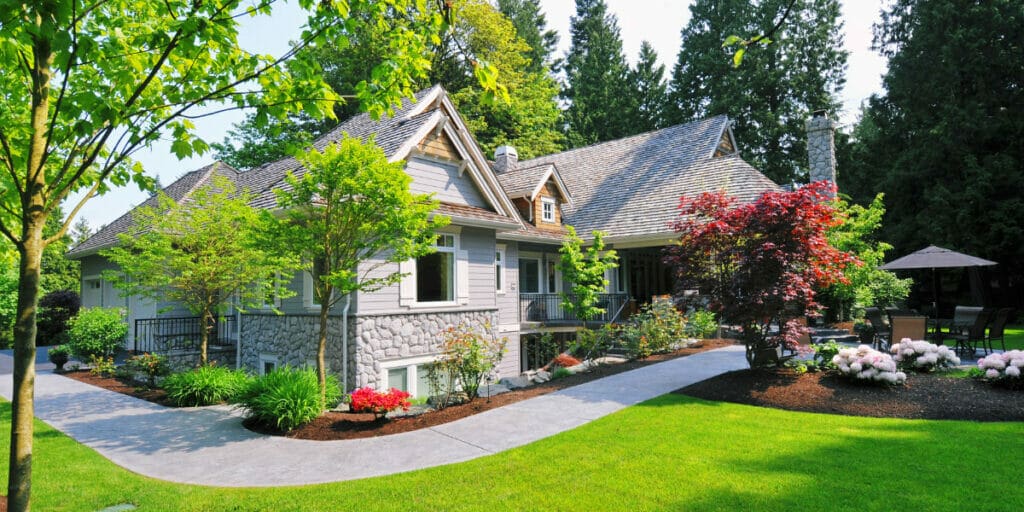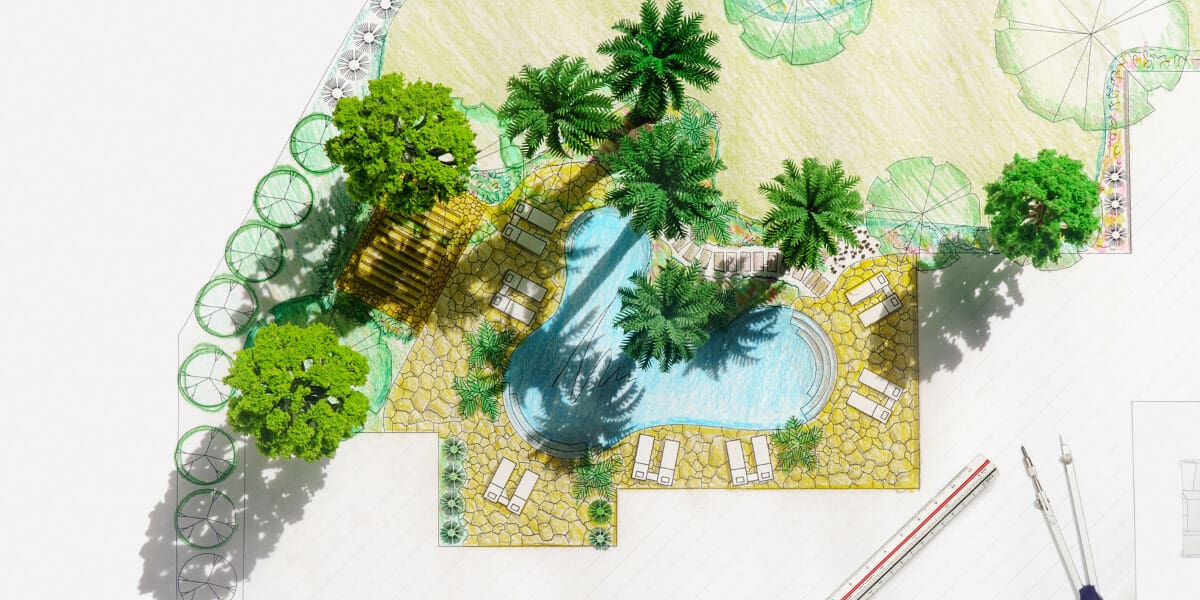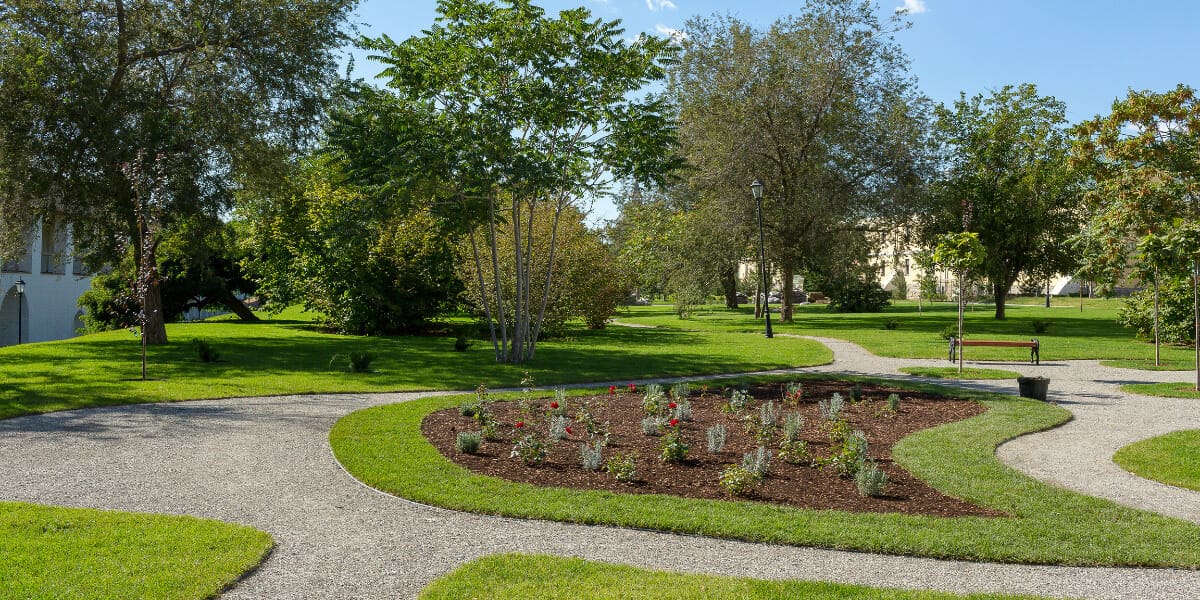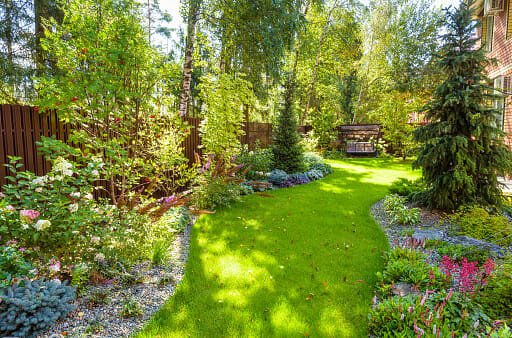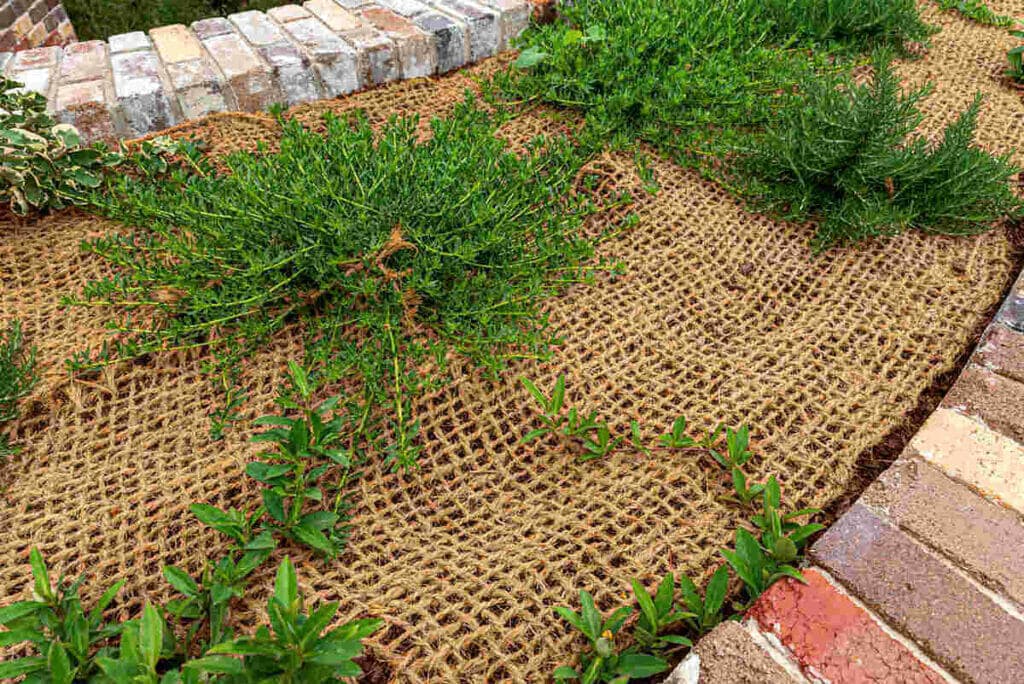Landscape Design Secrets for Skyrocketing Property Values
In the world of real estate, first impressions are paramount. The curb appeal of a property, often the initial glimpse potential buyers or renters encounter, holds immense significance in determining its overall value. It’s not just about aesthetics; it’s about making a lasting and positive impression. This blog post delves into the pivotal role of landscape design in enhancing curb appeal and, consequently, maximizing property value.
Landscape design, far more than mere aesthetics, plays a multifaceted role in influencing property value. It can transform an ordinary property into a captivating, inviting space. Beyond its visual impact, an effective landscape design can enhance functionality, foster sustainability, and even contribute to energy efficiency.
Our objective in this blog post is to provide you with insights, tips, and strategies on how to harness the potential of landscape design to optimize your property’s value. From selecting the right plants to designing functional outdoor spaces, we’ll explore a variety of elements and considerations that can turn your property into an attractive and valuable asset.
Understanding the Impact of Landscape Design on Property Value
- Numerous statistics and studies have consistently highlighted the strong correlation between landscaping and property value. Homes with well-maintained and thoughtfully designed landscapes tend to command higher prices in the real estate market. According to the National Association of Realtors, investing in landscaping can yield a return on investment (ROI) of up to 215%. Moreover, a study published in the Journal of Environmental Horticulture found that homes with enhanced landscaping had a 5.5% to 12.7% higher selling price compared to homes with minimal or no landscaping.
- The psychological benefits of a well-designed landscape also play a significant role in property value. A lush, aesthetically pleasing environment can create a positive atmosphere, reduce stress, and enhance overall well-being for homeowners. This contributes to the perception of a higher quality of life, making the property more desirable and potentially leading to higher resale values.
- The connection between landscaping and energy efficiency further underscores its impact on property value. Thoughtful landscape design can provide shade, windbreaks, and insulation, leading to reduced energy consumption for heating and cooling. This not only lowers utility bills but also makes the property more eco-friendly and appealing to environmentally-conscious buyers.
In conclusion, landscaping goes beyond mere aesthetics; it has a tangible and multifaceted influence on property value. The empirical evidence of its financial benefits, coupled with the psychological and energy efficiency advantages, emphasizes the crucial role that landscape design plays in enhancing property values and overall desirability in the real estate market.
Key Elements of Effective Landscape Design
Planning and layout
The Importance of a Well-Thought-Out Design Plan:
Effective landscape design begins with a meticulously crafted plan. This foundational step serves as the blueprint for the entire project, ensuring that every element harmoniously integrates into the outdoor space. A well-thought-out design plan takes into account the unique characteristics of the site, including its topography, soil quality, climate, and existing vegetation. By conducting a thorough site analysis, designers can make informed decisions that maximize the potential of the landscape.
Furthermore, a comprehensive design plan outlines the client’s objectives and preferences, whether it’s creating an inviting garden retreat, an entertainment space, or a sustainable ecosystem. It considers both short-term goals, such as plant selection and hardscape choices, and long-term considerations like maintenance requirements and growth patterns. A thoughtfully planned design also considers the principles of balance, proportion, and unity, ensuring a visually pleasing and functional landscape.
How to Incorporate Focal Points and Pathways:
Focal points and pathways are essential elements in landscape design that guide the viewer’s gaze and movement throughout the space. Focal points can be created using eye-catching elements such as a sculpture, a striking tree, or a water feature. These points of interest draw attention and add character to the landscape, creating visual diversity.
Pathways, on the other hand, serve both practical and aesthetic purposes. They guide people through the garden, connecting different areas and creating a sense of exploration. Materials like gravel, stone, or pavers can be used to define pathways, and their layout should be in harmony with the overall design plan. Curved pathways can add an organic feel, while straight lines can create a more formal atmosphere.
Incorporating focal points and pathways should be done with careful consideration of the overall design’s theme and style, ensuring that they enhance the overall aesthetic while providing functionality. Properly planned pathways and strategically placed focal points contribute to a well-balanced and visually appealing landscape design.
Plant Selection
One of the key elements of effective landscape design is plant selection, a crucial component that can significantly influence the aesthetics, sustainability, and maintenance requirements of a garden or outdoor space. Two vital aspects to consider within this category are the choice of native plants and seasonal considerations.
- Choosing Native Plants for Low Maintenance and Sustainability: Selecting native plants offers numerous benefits. Native species are adapted to the local climate, soil conditions, and wildlife, making them inherently hardy and resilient. They require less water, fertilizers, and pesticides than non-native counterparts, contributing to sustainable and eco-friendly landscaping. Furthermore, native plants often support local wildlife, such as pollinators and birds, fostering a healthy ecosystem. Reduced maintenance needs mean less time and effort spent on gardening chores, allowing homeowners to enjoy their landscapes more and spend less on upkeep.
- Seasonal Considerations for Year-round Appeal: Effective plant selection should encompass seasonal variations to ensure year-round visual appeal. This involves choosing plants that bloom at different times throughout the year, resulting in a dynamic and ever-changing landscape. Spring blossoms, summer foliage, fall colors, and winter interest can create a visually engaging environment regardless of the season. By carefully planning the timing of plantings, one can maintain a vibrant garden from the first hints of spring to the depths of winter. Seasonal diversity also promotes a sense of connection with nature, as the landscape continuously evolves, providing a rich and evolving experience for the observer.
Hardscape Features
Hardscape Features in landscape design play a pivotal role in shaping the functionality, aesthetics, and overall appeal of outdoor spaces. Here are key elements that contribute to effective hardscape design:
- Patios, Decks, and Outdoor Living Spaces: These are the heart of any landscape design, providing areas for relaxation, entertainment, and social gatherings. Patios offer a solid foundation for outdoor furniture, fire pits, and grills, while decks elevate the space with a raised platform. Thoughtful placement and design of these features ensure they seamlessly integrate with the natural surroundings, whether it’s a cozy corner with a pergola for shade or an expansive patio for larger gatherings.
- Walkways, Driveways, and Lighting: Walkways guide visitors through the landscape, creating a sense of direction and flow. Well-designed pathways are not only functional but also aesthetically pleasing, often incorporating materials that complement the overall theme of the design. Driveways should be both practical and visually appealing, with considerations for materials, drainage, and ease of access. Lighting, on the other hand, enhances safety and ambience. Pathway lights, spotlights, and accent lighting can transform the landscape after dark, making it usable and enchanting.
In summary, hardscape features are essential elements of landscape design that define how outdoor spaces are utilized and enjoyed. They should harmonize with the natural environment, ensuring a balance between functionality and beauty. Patios and decks create comfortable gathering areas, while walkways and driveways provide practical pathways. Properly designed lighting can extend the usability of the landscape into the evening hours. Combining these elements skillfully contributes to an effective landscape design that maximizes both form and function.
Water Features
Water features are a captivating component of effective landscape design, adding a sense of tranquility, aesthetic appeal, and natural beauty to outdoor spaces. When focusing on water features in landscaping, two key elements to consider are their allure and the necessary maintenance.
- The Allure of Water Elements: Water features, such as ponds, fountains, and waterfalls, have an irresistible charm. They create a soothing ambiance that can soothe the senses, providing a refreshing escape from the hustle and bustle of daily life. The gentle sound of flowing water, the shimmering reflections, and the interaction of light and water all contribute to a captivating visual and auditory experience. Water features also attract wildlife, enhancing the overall appeal of your outdoor space.
- Maintenance Considerations: While water features enhance aesthetics and ambiance, they require consistent maintenance to remain in their prime condition. Ponds need careful attention to water quality, including filtration and balancing, to prevent algae growth and maintain a healthy ecosystem for fish and plants. Fountains demand regular cleaning of nozzles and pumps to ensure uninterrupted flow. Waterfalls may require periodic inspection to ensure proper functionality and prevent debris blockages. Additionally, all water features may require winterization to protect them from freezing temperatures.
Effective maintenance involves routine cleaning, occasional repairs, and vigilant monitoring to address any issues promptly. Proper maintenance not only preserves the beauty and functionality of water features but also prolongs their lifespan, ensuring that they continue to be the focal point of your landscape design.
Incorporating water features thoughtfully and committing to their upkeep will enable you to fully harness their allure, enhancing the overall appeal and serenity of your outdoor space.
Sustainable Landscaping Practices
Effective landscape design with a focus on sustainable practices involves incorporating key elements that not only enhance the aesthetic appeal of outdoor spaces but also promote environmental responsibility. Two fundamental aspects of sustainable landscaping are xeriscaping and the use of eco-friendly materials and practices.
- Xeriscaping for Water Conservation: Xeriscaping is a water-efficient landscaping approach that reduces the need for excessive irrigation. It involves the strategic selection of drought-tolerant plants, mulching to retain soil moisture, and optimizing irrigation systems. By choosing native and adapted plant species that thrive in the local climate, homeowners and landscapers can significantly reduce water consumption, lower utility bills, and contribute to the preservation of water resources. Xeriscaping also minimizes soil erosion, enhances soil quality, and decreases the need for chemical fertilizers and pesticides, promoting overall environmental sustainability.
- Eco-friendly Materials and Practices: Sustainable landscaping prioritizes the use of environmentally friendly materials and practices throughout the design and maintenance processes. This includes selecting recycled or reclaimed materials for hardscape elements like paths and patios, as well as employing permeable paving to reduce runoff and support groundwater recharge. Additionally, eco-conscious landscaping involves organic gardening practices that avoid synthetic chemicals and pesticides, fostering a healthier ecosystem for beneficial insects and wildlife. Implementing efficient irrigation methods, such as drip systems or rain barrels, further conserves water resources.
Incorporating these key elements into landscape design not only creates visually appealing outdoor spaces but also contributes to the responsible use of natural resources. Sustainable landscaping practices not only benefit the environment but also provide homeowners with cost savings and a deeper connection to the ecosystems around them. By embracing xeriscaping and eco-friendly materials and practices, individuals can play an active role in conserving water, reducing waste, and promoting a more sustainable future.
Budgeting for Landscape Design
- Determining a budget for your landscaping project is a crucial first step in creating your dream outdoor space. Start by assessing your financial situation and setting a realistic spending limit. Consider factors such as the size of your yard, the complexity of the design, and any additional features like irrigation systems or lighting. Remember to allocate a portion of your budget for unexpected expenses that may arise during the project.
- Prioritizing landscaping elements based on your budget is essential to ensure you get the most value for your investment. Begin by identifying your must-have features, such as a patio, garden beds, or a new lawn. Then, rank other elements like decorative stones, water features, or extravagant plant varieties based on their importance to you. Adjust your plans to fit your budget while keeping the core components intact.
- Tips for cost-effective landscaping without compromising quality include researching and choosing local plants that thrive in your climate, as they tend to be more affordable and easier to maintain. Consider doing some of the work yourself, like planting and basic maintenance, to save on labor costs. Additionally, look for recycled or reclaimed materials for hardscaping elements like pathways or retaining walls. Lastly, plan for long-term savings by investing in energy-efficient outdoor lighting and low-water irrigation systems, which can reduce ongoing expenses.
By following these steps and being mindful of your budget, you can achieve a beautiful and functional landscape design that enhances your outdoor living space while staying within your financial means.
DIY vs. Professional Landscaping
The Advantages of Hiring a Professional Landscaper:
Professional landscapers bring expertise and experience to the table. They can transform your outdoor space into a stunning and functional oasis. Their knowledge of soil quality, plant selection, and horticultural practices ensures a thriving landscape. Moreover, they have access to a wide range of tools and equipment, allowing for efficient execution of landscaping projects.
Another advantage is time-saving. Landscaping projects can be time-consuming for DIY enthusiasts, while professionals can complete tasks more swiftly. Additionally, professional landscapers can provide detailed designs and comprehensive plans that maximize the potential of your space, enhancing both aesthetics and functionality.
DIY Landscaping Tips for Homeowners with a Tight Budget:
DIY landscaping can be a cost-effective alternative. Start by setting a clear budget and prioritizing essential tasks. Research and select low-maintenance plants that suit your climate and soil conditions. Consider reusing existing materials and repurposing items to save on costs. Group similar plants together for a cohesive look, and install irrigation systems to conserve water.
Furthermore, learn basic landscaping techniques like mulching, edging, and proper planting depth. By tackling smaller projects over time, you can gradually improve your landscape without breaking the bank.
Balancing DIY Efforts with Professional Guidance:
A hybrid approach is often ideal. DIY projects can be fulfilling, but it’s crucial to know your limits. Consult with a professional for initial planning and guidance, especially when dealing with complex tasks or large-scale projects. Professionals can advise on crucial aspects like drainage, grading, and structural elements.
Overall, finding the right balance between DIY efforts and professional expertise is key to achieving a beautiful and functional landscape while managing costs effectively.
Maintaining Your Landscape Investment
Maintaining Your Landscape Investment is crucial for preserving the beauty and functionality of your outdoor space. To ensure optimal curb appeal throughout the year, it’s essential to establish seasonal maintenance routines. In spring, focus on cleaning up debris, pruning shrubs, and planting new flowers. Summer requires regular mowing, weeding, and mulching to keep your lawn vibrant. Fall is the time for leaf removal, aeration, and preparing plants for winter, while winter involves protecting your garden from frost and snow.
Irrigation and fertilization are key elements in landscape care. Adequate watering, especially during dry spells, keeps your plants healthy. Consider installing an efficient irrigation system to ensure consistent hydration. Fertilization provides essential nutrients to the soil, promoting robust growth and vibrant colors. Select the right fertilizers and follow a proper schedule for best results.
Addressing common landscape issues promptly is vital. Pests, diseases, and weed infestations can quickly spread if left unchecked. Regular inspections can help you identify and treat these problems early, preserving the integrity of your investment. Also, monitor for soil erosion and drainage issues to prevent damage to hardscapes and plantings.
In conclusion, maintaining your landscape investment requires a proactive approach. Implementing seasonal routines, prioritizing irrigation and fertilization, and promptly addressing issues will ensure that your outdoor space continues to enhance your property’s appeal and value for years to come. It’s an investment of time and effort that pays off in the form of a lush, thriving, and aesthetically pleasing landscape.
Case Studies: Real-Life Examples of Property Value Enhancement
Before-and-after examples showcasing the impact of landscape design: In the realm of property value enhancement, before-and-after case studies are a powerful tool to illustrate the transformative potential of landscape design. These studies provide tangible evidence of how a well-executed landscaping project can significantly increase the value of a property.
Consider a case where a neglected backyard with overgrown vegetation, uneven terrain, and poor lighting is transformed into a stunning oasis with lush gardens, a well-maintained lawn, and strategically placed outdoor lighting. Such visual comparisons vividly demonstrate the enhancement in property aesthetics and functionality.
Moreover, before-and-after photographs highlight how landscaping can address practical concerns, like erosion control and water drainage, which can impact a property’s long-term value. By showcasing the successful mitigation of these issues, these case studies underscore the importance of thoughtful landscape design in maintaining and enhancing property worth.
Testimonials from homeowners who’ve increased property value through landscaping: In addition to before-and-after examples, testimonials from homeowners who have experienced property value enhancement through landscaping offer valuable insights. These firsthand accounts provide a personal touch to the success stories, emphasizing the emotional and financial benefits of their investments.
Homeowners can share their experiences about how landscaping not only improved the curb appeal but also created functional outdoor spaces for recreation and relaxation. These testimonials often highlight the increase in property resale value, which can be a compelling factor for potential investors.
Furthermore, hearing from real homeowners can address common concerns and doubts, such as the return on investment for landscaping projects. Their narratives can instill confidence in prospective property owners looking to enhance their homes’ value through landscaping, making these testimonials a persuasive and informative component of case studies in property value enhancement.
Conclusion
Promoting effective landscape design offers a myriad of benefits to both homeowners and their communities. Firstly, it serves as a form of encouragement for homeowners to invest in their outdoor spaces, fostering a sense of pride and connection to their property. This investment not only enhances the visual appeal but also contributes to a healthier environment by promoting biodiversity and reducing carbon footprints through the planting of trees and native plants.
Furthermore, the long-term advantages of maximizing property value through landscaping are undeniable. A well-designed landscape not only increases curb appeal but also adds significant financial value to a property. It can lead to higher resale prices, quicker property turnover, and a stronger sense of community as neighbors are inspired to follow suit. Moreover, landscaping can improve energy efficiency, reduce maintenance costs, and create outdoor spaces for leisure and recreation.
In essence, prioritizing effective landscape design is a win-win situation, benefiting homeowners personally while also contributing positively to the overall quality of residential areas. Such investments yield not only aesthetic dividends but also long-term financial and environmental rewards.

